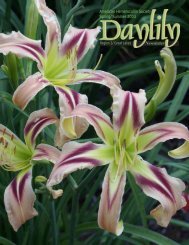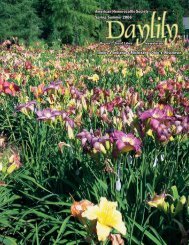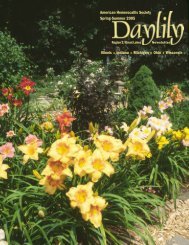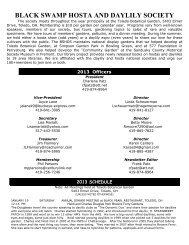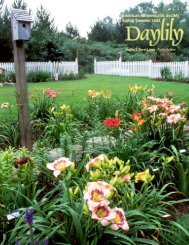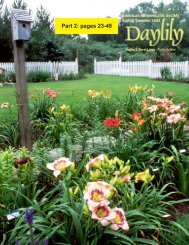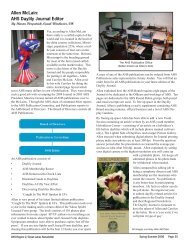Pages - AHS Region 2
Pages - AHS Region 2
Pages - AHS Region 2
Create successful ePaper yourself
Turn your PDF publications into a flip-book with our unique Google optimized e-Paper software.
One Step Closer to a Mixed Border<br />
By Lynn Purse, Pittsburgh, Pennsylvania<br />
C<br />
ompanion planting is near and dear to my heart; I’ve grown<br />
daylilies in what is known as mixed borders for years. I<br />
grew up on an organic farm and monoculture was<br />
considered a dirty word, even in the 1960s. “The more diverse the<br />
plantings, the healthier the garden,” “feed the soil, not the plants”<br />
and so on. After gardening intensely for many years, I have<br />
found those litanies to be true. It also makes for a more interesting<br />
garden with a very long period of color and texture and evokes the<br />
artist in me. Having moved to a new place a few years ago and had<br />
the overwhelming experience of building large garden areas in one<br />
season instead of over a period of years, I have this to share.<br />
To anyone wanting to diversity their daylily gardens, I would<br />
recommend starting with small shrubs that are mixed into the garden<br />
beds. Annuals and other perennials can be added once the structural<br />
plants are in place. As I was building my gardens the first year, I<br />
spent 90% of my plant budget on small trees and shrubs, knowing<br />
that these needed to be in place first to build a woody structure that<br />
would show off the daylilies and other plants to their best advantage.<br />
By the end of the first season, the garden looked like it was in its<br />
third year rather than its first. Medium to tall shrubs are great<br />
background builders but what I look for in shrubs that mix right into<br />
the border are polite beings that mind their manners in the garden,<br />
stay reasonably small, respond well to pruning and shaping, and<br />
offer great foliage from spring through fall. Flowers are a bonus,<br />
though I do use small shrub type roses in the same way, especially<br />
the polyantha types. I rarely use needled evergreen shrubs mixed<br />
in the border, as their foliage can be permanently damaged if they<br />
are shaded too much by other plants.<br />
Most of my “backbone” shrubs are hardy in Zones 5-8, but it<br />
pays to visit botanical gardens in your area to see what would grow<br />
well for you. The following plants form the foundation of my Zone<br />
5-b garden and work quite well as part of a garden featuring daylilies.<br />
many small and beautifully colored ones are now available and<br />
they rarely self seed like the species types. Favorites are Berberis<br />
‘Crimson Pygmy’, which stays 1.5-2', and emerges in spring with<br />
almost black foliage that turns a dark burgundy. B. ‘Bagatelle’ is<br />
very similar. Both work very well with hot colored daylilies, the<br />
deep red foliage acting as a foil to the brighter flower tones of red<br />
and orange. A new red barberry on the market is B. ‘Concorde’,<br />
another dwarf that has more of a purple cast to the foliage instead<br />
of burgundy—this one looks great near the dark rose purple daylilies<br />
like Hemerocallis ‘Nosferatu’ (Hanson 1990) and H. ‘Round<br />
Midnight’ (R. Mercer 1992). A particular favorite is Berberis ‘Rose<br />
Glow’, which has mottled rose and burgundy foliage that I like to<br />
pair with dark eyed daylilies like Hemerocallis ‘Siloam Merle Kent’ (P.<br />
Henry 1984) and vibrant rose lavenders like H. ‘Chance Encounter’<br />
(Stamile 1994). Barberry ‘Rose Glow’ needs more pruning in the spring<br />
to keep it a manageable size; just cut out any long straight stems at<br />
the base and keep the short twiggy growth (protect yourself with<br />
long sleeves and gloves—these plants are thorny!). B. ‘Helmut’s<br />
Pillar’ is another burgundy leaf cultivar that grows in columnar<br />
form, very useful for a punctuation point at the end of a bed. Being<br />
new and unusual, it is still somewhat pricey.<br />
The golden barberries are useful as well; the yellow Berberis ‘Aurea’<br />
is best in some shade while B. ’Bonanza Gold’ can take full sun but<br />
is a brassier shade of gold. Both of these combine beautifully with<br />
yellow selfs and whites edged in gold, like Hemerocallis ‘Wedding<br />
Dance’ (Joiner 1983), as well as purples and lavenders with yellow<br />
throats.<br />
Spireas are another great plant for the daylily garden, offering<br />
foliage color from early spring to late fall and sometimes some great<br />
flowers as well, depending on the variety. Two of my favorites are<br />
Spirea thunbergii ‘Goldflame’, which can get to 3', and S. ‘Magic<br />
Carpet’, which stays closer to 2'. I prune both types back to 1-1.5' in<br />
early spring as soon as leaf buds begin to show. The foliage color<br />
on these plants are their claim to fame; they emerge a brilliant blend<br />
of gold, coral, and bronze, transform into soft chartreuse in May,<br />
Hemerocallis ‘Nosferatu’ in front of Berberis‘Rose Glow’<br />
I have limited myself here to the small inexpensive border shrubs<br />
that are easy to grow and easy to add to a daylily bed.<br />
Barberries (berberis) are an extremely useful group; the green<br />
ones were used in town gardens in Pittsburgh for years as hedges,<br />
known colloquially as “jagger bushes” and were good for keeping<br />
the neighbor kids out of your yard. Fortunately for the gardener,<br />
<strong>AHS</strong> <strong>Region</strong> 2/Great Lakes Newsletter<br />
A pink carpet rose,<br />
Spirea ‘Shibori’<br />
and Hemerocallis<br />
‘Berlioz’<br />
(Moldovan 1983)<br />
and H. Wind Frills’<br />
(Tarrant 1978)<br />
Fall 2005 - Winter 2006 Page 39



